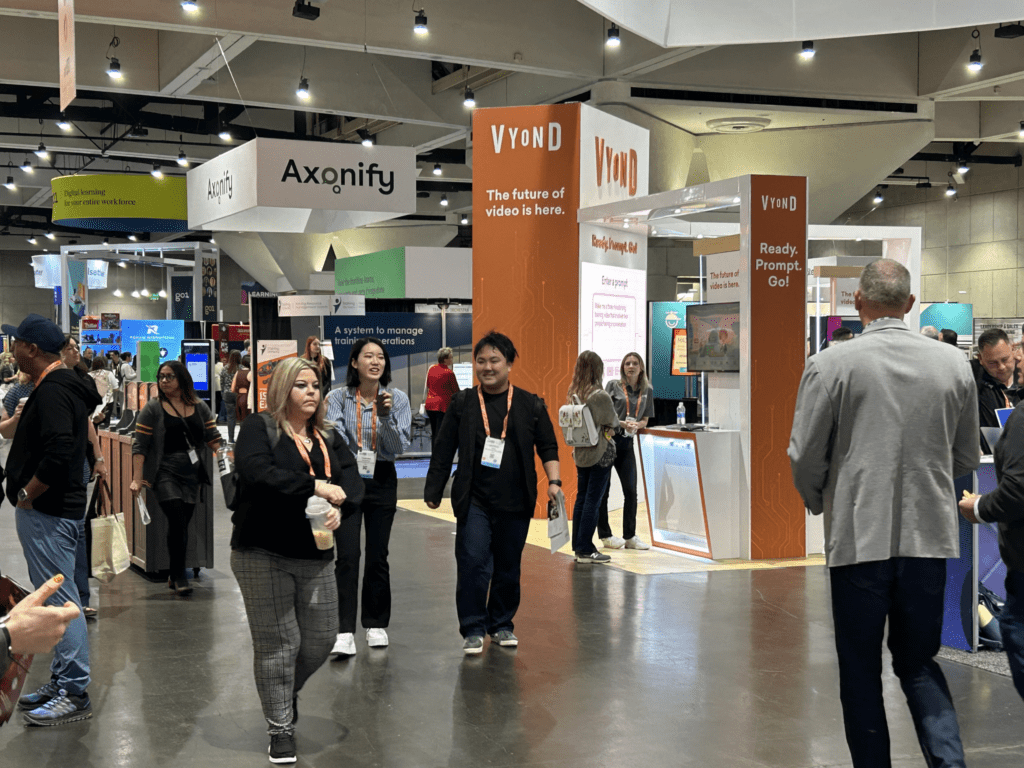Dispatches from ATD23: Tuesday
We’re still living it up at the ATD International Annual Conference, soaking in all the trends and talks from the show floor! Here are four of the trends we saw—and overheard—on the show floor today. (Psst…If you missed our Monday dispatch, check it out here.)

Building community and togetherness with a delicate balance of “I versus We”
Author and dialogue facilitator Priya Parker’s keynote explored the idea of gathering together, and what that means in virtual, hybrid and in-person settings. In fact, it was the topic of her book, The Art of Gathering: How We Meet and Why It Matters, which launched, unfortunately, in April 2020 (“It was awkward,” she joked).
This idea of meaningful togetherness has a lot of implications for the frontline world, where the desperate need for employee community is tempered by its diverse, distributed workforces; we could think of “gathering” in this context as a broader community, united within various enablement systems and processes. “We ask ‘Do I belong here?’ when we enter a gathering. ‘Are these my people, and do I want to be here?’,” Parker explains.
Parker shared a lot of insights around the power of these gatherings, and the exciting turning point that L&D finds itself at as people look at the social infrastructure of how we meet. But one of the most exciting insights was the need to find the balance between a collective sense of group, and the unique viewpoints of each individual.
“When the gathering is all ‘we’, it’s a cult. When it’s all ‘I’, it’s a federation,” she said. But a strong community is possible when you find the right mix of the two.

“Learning can’t be school”
“Work has changed. Our ability to enable and support that work hasn’t kept pace,” explained JD Dillon, Axonify’s Chief Learning Architect, in his session exploring the modern learning mindset. And at the core of this refreshing approach to learning is a simple assertion: we need to acknowledge that learning can no longer be like school. That means pulling learning into the flow of work, using data to get more predictive, driving an equitable experience at scale—and building a system that can keep up with the pace of work.
“The goalpost keeps moving,” said Dillon. “Whatever that next change is, we don’t have to completely rework the wheel to keep pace with business.”
But one of the biggest—and simplest—takeaways from the session was that learning isn’t the goal. “What are we actually helping people do?” asked Dillon, explaining that learning is a tool in a bigger toolbox helping people get work done. This sentiment was echoed in a session with Robert Mosher and Conrad Gottfredson of Apply Synergies. “Training is a tool for carpentry. It’s not who we are. We’re performance enablement consultants,” explained Mosher. In other words: training is just one of the means to achieve effective on-the-job performance.
Using AI to accelerate content development
AI was—of course—on everyone’s minds throughout the show: how and when to use it and what it can do. “Working in AI for the past six years, we’ve never seen anything like it. These capabilities are endless,” said Luke Barns of “answer engine” tool Lucy in a session. “I’d be lying if I said I didn’t consider using Chat GPT for my speaker notes today.”
But the most prevalent use case at ATD was applying AI for content creation—from videos and course authoring to chatbots—to save time and cut costs. Using AI like this also brings more non-L&D stakeholders into the enablement process; instead of project-managing subject matter experts, L&D teams can enable SMEs to do it themselves.

Data storytelling for inspiring DEI action
Our dispatch yesterday highlighted a need for simplified data to influence senior stakeholders to buy into modern learning strategies. For diversity, equity and inclusion programs, there’s a need to go even further.
“How many of you have presented data at your organization and it dropped like a thud?” asked Margaret Spence of the Inclusion Learning Lab. “This broad data dump doesn’t work.”
In other words, a dashboard won’t inspire buy-in to change; we’re over-relying on data and stats to communicate an emotional process. What’s the alternative? Storytelling.
“Data is people. Period. Your data is people having real experiences within your system and structures,” said Spence. “DEI is heart work, not brain work.”
Of course, Spence wasn’t suggesting that all DEI data goes in the garbage (“Don’t blow up the dashboards,” she warned). But she talked about the power of weaving those numbers into a story that helps stakeholders connect emotionally. “Then the data enhances your story and supercharges action,” she said.
What were your biggest takeaways from ATD23? Tell us on LinkedIn!